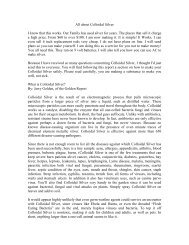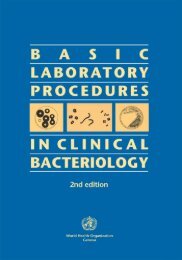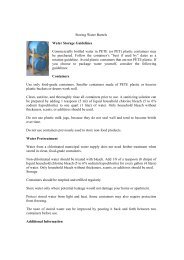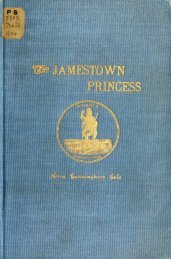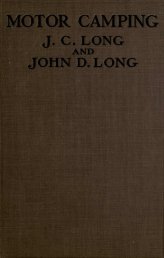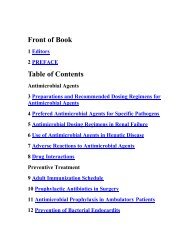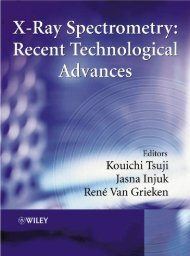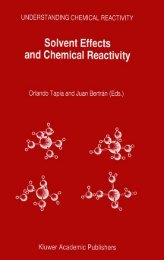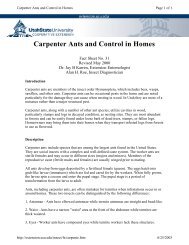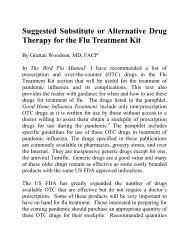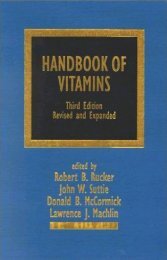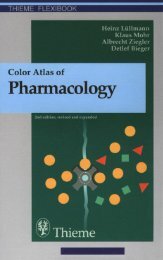Introduction: A history <strong>of</strong> chromium studies (1955–1995) 29[15] Cambell, W. J., and Mertz, W. (1963) Interaction <strong>of</strong> insulin and chromium(<strong>III</strong>) on mitochondrialswelling. Am. J. Physiol. 204, 1028–1030.[16] Evans, G. W., Roginski, E. E., and Mertz, W. (1973) Interaction <strong>of</strong> the glucose tolerancefactor (GTF) with insulin. Biochem. Biophys. Res. Commun. 50, 718–722.[17] Votava, H. J., Hahn, C. J., and Evans, G. W. (1973) Isolation and partial characterization<strong>of</strong> a 51Cr complex from brewers’ yeast. Biochem. Biophys. Res. Commun. 55, 312–319.[18] Toepfer, E. W., Mertz, W., Polansky, M. M., Roginski, E. E., and Wolf, W. R. (1977) Preparation<strong>of</strong> chromium-containing material <strong>of</strong> glucose tolerance factor activity from brewer’syeast extracts and by synthesis. J. Agric. Food Chem. 25, 162–162.[19] Anderson, R. A., and Mertz, W. (1977) Glucose tolerance factor: an essential dietary agent.Trends Biochem. Sci. 2, 277–279.[20] Kumpulainen, J., Koivistoinen, P., and Lahtinen, S. (1978) Isolation, purification, andpartial chemical characterization <strong>of</strong> chromium(<strong>III</strong>) fractions existing in brewer’s yeast andSabouraud’s liquid medium. Bioinorg. Chem. 8, 419–429.[21] Gonzalez-Vergara, E., Hegenauer, J., and Saltman, P. (1982) Biological complexes <strong>of</strong>chromium: A second look at glucose tolerance factor. Fed. Proc. 41, 286.[22] Held, D. D., Gonzalez-Vergara, E., and G<strong>of</strong>f, H. M. (1984) Isolation <strong>of</strong> a non-chromiuminsulin-enhancing factor from brewer’s yeast. Fed. Proc. 43, 472.[23] Haylock, S. J., Buckley, P. D., and Blackwell, L. F. (1983) Separation <strong>of</strong> biologically activechromium-containing complexes from yeast extracts and other sources <strong>of</strong> glucose tolerancefactor (GTF) activity. J. Inorg. Biochem. 18, 195–211.[24] Mirsky, N., Weiss, A., and Dori, Z. (1980) <strong>Chromium</strong> in biological systems, I. Someobservations on glucose tolerance factor in yeast. J. Inorg. Biochem. 13, 11–21.[25] Mirsky, N., Weiss, A., and Dori, Z. (1981) <strong>The</strong> effect <strong>of</strong> glucose tolerance factor on glucoseuptake by yeast cells. J. Inorg. Biochem. 15, 275–279.[26] Holdsworth, E. S., and Appleby, G. (1984) Assays <strong>of</strong> glucose tolerance factor and its mode<strong>of</strong> action, studied with brewer’s yeast. J. Inorg. Biochem. 21, 31–44.[27] Mirsky, N. (1993) Glucose tolerance factor reduces blood glucose and free fatty acids levelsin diabetic rats. J. Inorg. Biochem. 49, 123–128.[28] Mirsky, N., and Berdicevsky, I. (1994) Effects <strong>of</strong> insulin and glucose tolerance factor onglucose uptake by yeast cells. Biol. Signals 3, 271–277.[29] Berdicevsky, I., and Mirsky, N. (1994) Effects <strong>of</strong> insulin and glucose tolerance factor (GTF)on growth <strong>of</strong> Saccharomyces cerevisiae. Mycoses 37, 405–410.[30] Muller, G., Rouveyre, N., Crecelius, A., and Bandlow, W. (1998) Insulin signaling in theyeast Saccharomyces cerevisiae. 1. Stimulation <strong>of</strong> glucose metabolism and Snf1 kinase byhuman insulin. <strong>Biochemistry</strong> 37, 8683–8695.[31] Muller, G., Rouveyre, N., Upshon, C., Gross, E., and Bandlow, W. (1998) Insulin signalingin the yeast Saccharomyces cerevisiae. 2. Interaction <strong>of</strong> human insulin with a putativebinding protein. <strong>Biochemistry</strong> 37, 8696–8704.[32] Muller, G., Rouveyre, N., Upshon, C., and Bandlow, W. (1998) Insulin signaling in theyeast Saccharomyces cerevisiae. 3. Induction <strong>of</strong> protein phosphorylation by human insulin.<strong>Biochemistry</strong> 37, 8705–8713.[33] Haylock, S. J., Buckley, P. D., and Blackwell, L. F. (1983) <strong>The</strong> relationship <strong>of</strong> chromiumto the glucose tolerance factor. II. J. Inorg. Biochem. 19, 105–117.[34] Davies, D. M., Holdsworth, E. S., and Sherriff, J. L. (1985) <strong>The</strong> isolation <strong>of</strong> glucosetolerance factors from brewer’s yeast and their relationship to chromium. Biochem. Med.33, 297–311.[35] Holdsworth, E. S., and Neville, E. (1988) Extracts <strong>of</strong> brewer’s yeast contain GABA whichenhances activation <strong>of</strong> glycogen synthetase by insulin in isolated rat hepatocytes. Biochem.Int. 17, 1107–1116.
30 John B. Vincent and Dontarie Stallings[36] Holdsworth, E. S., and Neville, E. (1990) Effects <strong>of</strong> extracts <strong>of</strong> high- and low-chromiumbrewer’s yeast on metabolism <strong>of</strong> glucose by hepatocytes from rats fed on high- or low-Crdiets. Br. J. Nutr. 63, 623–630.[37] Holdsworth, E. S., Kaufman, D. V., and Neville, E. (1991) A fraction derived from brewer’syeast inhibits cholesterol synthesis by rat liver preparations in vitro. Br. J. Nutr. 65, 285–299.[38] Hwang, D. L., Lev-Ran, A., Papoian, T., and Beech, W. K. (1987) Insulin-like activity <strong>of</strong>chromium-binding fractions from brewer’s yeast. J. Inorg. Biochem. 30, 219–225.[39] Simon<strong>of</strong>f, M., Shapcott, D., Alameddine, S., Sutter-Dub, M. T., and Simon<strong>of</strong>f, G. (1992) <strong>The</strong>isolation <strong>of</strong> glucose tolerance factors from Brewer’s yeast and their relation to chromium.Biol. Trace Elem. Res. 32, 25–38.[40] Anderson, R. A., Brantner, J. H., and Polansky, M. M. (1978) An improved assay forbiologically active chromium. J. Agric. Food Chem. 26, 1219–1221.[41] Vincent, J. B. (1994) Relationship between glucose tolerance factor and low-molecularweightchromium-binding substance. J. Nutr. 124, 117–119.[42] Mertz, W. (1994) Reply to the letter <strong>of</strong> Dr. Vincent. J. Nutr. 124, 119.[43] Gutierrez, J., Mertz, W., Toepfer, E. W., Polansky, M. M., and Roginski, E. E. (1974) Saccharomycescarlsbergensis: microbiological assay for unidentified factor related to glucosetolerance. J. Agric. Food Chem. 22, 100–103.[44] Sumrall, K. H., and Vincent, J. B. (1997) Is glucose tolerance factor an artifact producedby acid hydrolysis <strong>of</strong> low-molecular-weight chromium-binding substance? Polyhedron 16,4171–4177.[45] Woolliscr<strong>of</strong>t, J., and Barbosa, J. (1977) Analysis <strong>of</strong> chromium induced carbohydrate intolerancein the rat. J. Nutr. 107, 1702–1706.[46] Shepherd, P. R., Elwood, C., Buckley, P. D., and Blackwell, L. F. (1992) Glucose tolerancefactor putentiation <strong>of</strong> insulin action in adipocytes from rats raised on a Torula yeast dietcannot be attributed to a deficiency <strong>of</strong> chromium. Biol. Trace Elem. Res. 32, 109–113.[47] Gonzalez-Vergara, E., Gonzalez, B. C. D., Hegenauer, J., and Saltman, P. (1981) <strong>Chromium</strong>coordination compounds <strong>of</strong> pyridoxal and nicotinic acid: Synthesis, absorptionh andmetabolism. Israel J. Chem. 21, 18.[48] Gonzalez-Vergara, E., Hegenauer, J., Saltman, P., Sabat, M., and Ibers, J. A. (1982) Synthesisand structure <strong>of</strong> a trinuclear chromium(<strong>III</strong>)-nicotinic acid complex. Inorg. Chim. Acta66, 115–118.[49] Gerdom, L. E., and G<strong>of</strong>f, H. M. (1982) Ligation modes for nicotinic acid binding to thechromium(<strong>III</strong>) salen complex. Inorg. Chem. 21, 3847–3848.[50] McArdle, J. V., de Laubenfels, E., Shorter, A. L., and Ammon, H. L. (1982) <strong>The</strong> synthesisand structure <strong>of</strong> bis(methylnicotinate)aquatrichlorochromium(<strong>III</strong>). Polyhedron 1, 471–474.[51] Chang, J. C., Gerdom, L. E., Baenziger, N. C., and G<strong>of</strong>f, H. M. (1983) Synthesis andmolecular structure determination <strong>of</strong> carboxyl bound nicotinic acid (niacin) complexes <strong>of</strong>chromium(<strong>III</strong>). Inorg. Chem. 22, 1739–1744.[52] Cooper, J. A., Anderson, B. F., Buckley, P. D., and Blackwell, L. F. (1984) Structureand biological activity <strong>of</strong> nitrogen and oxygen coordinated nicotinic acid complexes <strong>of</strong>chromium. Inorg. Chim. Acta 91, 1–9.[53] Green, C. A., Bianchini, R. J., and Legg, J. I. (1984) Characterization <strong>of</strong> a stablechromium(<strong>III</strong>)-nicotinic acid complex by deuteron NMR. Inorg. Chem. 23, 2713–2715.[54] Cooper, J. A., Blackwell, L. F., and Buckley, P. D. (1984) <strong>Chromium</strong>(<strong>III</strong>) complexes andtheir relationship to the glucose tolerance factor. Part II. Structure and biological activity<strong>of</strong> amino acid complexes. Inorg. Chim. Acta 92, 23–31.[55] Barrett, J., Kormoh, M. K., and O’Brien, P. (1985) Preparation and characterization <strong>of</strong> someCr(<strong>III</strong>) chloro-complexes with nicotinic acid esters. Inorg. Chim. Acta 107, 269–274.
- Page 2 and 3: The Nutritional Biochemistryof Chro
- Page 4 and 5: The NutritionalBiochemistry ofChrom
- Page 6 and 7: Table of ContentsPrefaceContributor
- Page 8 and 9: PrefaceThe manufacture and sale of
- Page 10 and 11: Prefaceixdiscuss the implications o
- Page 12 and 13: ContributorsD. BagchiInterHealth Re
- Page 14 and 15: Chapter 1Introduction: A history of
- Page 16 and 17: Introduction: A history of chromium
- Page 18 and 19: Introduction: A history of chromium
- Page 20 and 21: Introduction: A history of chromium
- Page 22 and 23: Introduction: A history of chromium
- Page 24 and 25: Introduction: A history of chromium
- Page 26 and 27: Introduction: A history of chromium
- Page 28 and 29: Introduction: A history of chromium
- Page 30 and 31: Introduction: A history of chromium
- Page 32 and 33: Introduction: A history of chromium
- Page 34 and 35: Introduction: A history of chromium
- Page 36 and 37: Introduction: A history of chromium
- Page 38 and 39: Introduction: A history of chromium
- Page 40 and 41: Introduction: A history of chromium
- Page 44 and 45: Introduction: A history of chromium
- Page 46 and 47: Introduction: A history of chromium
- Page 48 and 49: Introduction: A history of chromium
- Page 50 and 51: Introduction: A history of chromium
- Page 52 and 53: Introduction: A history of chromium
- Page 54 and 55: Part IChromium as a nutrient and nu
- Page 56: Chapter 2Basis for dietary recommen
- Page 59 and 60: 46 Barbara J. Stoeckerof supplement
- Page 61 and 62: 48 Barbara J. StoeckerREPORTED CHRO
- Page 63 and 64: 50 Barbara J. Stoeckerhigh fiber di
- Page 65 and 66: 52 Barbara J. StoeckerEFFECTS OF ME
- Page 67 and 68: 54 Barbara J. Stoecker[26] Mohameds
- Page 69 and 70: This page intentionally left blank
- Page 71 and 72: 58 Diane M. Stearnsabout his intell
- Page 73 and 74: 60 Diane M. StearnsMertz and cowork
- Page 75 and 76: 62 Diane M. StearnsCr 6+ or Cr 3+ r
- Page 77 and 78: 64 Diane M. Stearnsdiabetes [68-71]
- Page 79 and 80: 66 Diane M. Stearns[4] Boynton, H.,
- Page 81 and 82: 68 Diane M. Stearns[49] Vincent, J.
- Page 83 and 84: 70 Diane M. Stearns[89] Snow, E. T.
- Page 85 and 86: 72 Henry C. LukaskiThis chapter cri
- Page 87 and 88: 74 Henry C. Lukaski(1.8% vs 0.9 kg)
- Page 89 and 90: 76 Henry C. Lukaskiexercise. These
- Page 91 and 92: 78 Henry C. Lukaskiits putative rol
- Page 93 and 94:
Table 1Effects of chromium (Cr) sup
- Page 95 and 96:
82 Henry C. LukaskiSOME RESOLUTION
- Page 97 and 98:
84 Henry C. Lukaski[27] Lefavi, R.
- Page 99 and 100:
86 Merlin D. LindemannThe feed indu
- Page 101 and 102:
88 Merlin D. LindemannSWINEIntroduc
- Page 103 and 104:
90 Merlin D. Lindemannstudy [19], a
- Page 105 and 106:
92 Merlin D. Lindemann(VT) [13] cor
- Page 107 and 108:
94 Merlin D. LindemannEffects on ca
- Page 109 and 110:
96 Merlin D. LindemannTable 3Effect
- Page 111 and 112:
98 Merlin D. Lindemanninsulin [13];
- Page 113 and 114:
100 Merlin D. Lindemannno observed
- Page 115 and 116:
102 Merlin D. LindemannChromium for
- Page 117 and 118:
104 Merlin D. LindemannA dose-respo
- Page 119 and 120:
106 Merlin D. LindemannTable 5Effec
- Page 121 and 122:
108 Merlin D. LindemannSHEEPIntrodu
- Page 123 and 124:
110 Merlin D. Lindemannwere not sta
- Page 125 and 126:
112 Merlin D. Lindemann[6] National
- Page 127 and 128:
114 Merlin D. Lindemann[41] Gundel,
- Page 129 and 130:
116 Merlin D. Lindemann[75] Kegley,
- Page 131 and 132:
118 Merlin D. Lindemann[113] Xianli
- Page 133 and 134:
This page intentionally left blank
- Page 135 and 136:
122 Weiyue FengTable 1Absorption of
- Page 137 and 138:
124 Weiyue Fengto transferrin and t
- Page 139 and 140:
126 Weiyue FengKd = [Cr 51 in LMWCr
- Page 141 and 142:
128 Weiyue Fengdistribution in anim
- Page 143 and 144:
130 Weiyue FengEXCRETIONAbsorbed ch
- Page 145 and 146:
132 Weiyue FengApochromodulinApochr
- Page 147 and 148:
134 Weiyue Feng[7] Gargas, M. L., N
- Page 149 and 150:
136 Weiyue Feng[48] Vincent, J. B.
- Page 151 and 152:
This page intentionally left blank
- Page 153 and 154:
140 John B. Vincent and Randall Ben
- Page 155 and 156:
142 John B. Vincent and Randall Ben
- Page 157 and 158:
144 John B. Vincent and Randall Ben
- Page 159 and 160:
146 John B. Vincent and Randall Ben
- Page 161 and 162:
148 John B. Vincent and Randall Ben
- Page 163 and 164:
150 John B. Vincent and Randall Ben
- Page 165 and 166:
152 John B. Vincent and Randall Ben
- Page 167 and 168:
154 John B. Vincent and Randall Ben
- Page 169 and 170:
156 John B. Vincent and Randall Ben
- Page 171 and 172:
158 John B. Vincent and Randall Ben
- Page 173 and 174:
160 John B. Vincent and Randall Ben
- Page 175 and 176:
This page intentionally left blank
- Page 177 and 178:
164 William T. Cefaluinsulin requir
- Page 179 and 180:
Table 1(Continued)ReferenceStudytyp
- Page 181 and 182:
168 William T. Cefalu160Fasting ins
- Page 183 and 184:
170 William T. Cefalurisk factors f
- Page 185 and 186:
172 William T. CefaluMeta-analysis
- Page 187 and 188:
174 William T. CefaluMinority ethni
- Page 189 and 190:
176 William T. Cefalurelate to insu
- Page 191 and 192:
178 William T. Cefalu[24] Jovanovic
- Page 193 and 194:
180 William T. Cefalu[60] Ford, E.
- Page 195 and 196:
This page intentionally left blank
- Page 197 and 198:
184 S. Zafra-Stone et al.to impaire
- Page 199 and 200:
186 S. Zafra-Stone et al.testes, an
- Page 201 and 202:
188 S. Zafra-Stone et al.impeding t
- Page 203 and 204:
190 S. Zafra-Stone et al.180160140G
- Page 205 and 206:
192 S. Zafra-Stone et al.with eleva
- Page 207 and 208:
194 S. Zafra-Stone et al.fed a diet
- Page 209 and 210:
196 S. Zafra-Stone et al.1.14 ± 0.
- Page 211 and 212:
198 S. Zafra-Stone et al.Grant et a
- Page 213 and 214:
200 S. Zafra-Stone et al.difference
- Page 215 and 216:
202 S. Zafra-Stone et al.regulating
- Page 217 and 218:
204 S. Zafra-Stone et al.[32] Shind
- Page 219 and 220:
206 S. Zafra-Stone et al.[66] Pasma
- Page 221 and 222:
This page intentionally left blank
- Page 223 and 224:
210 Diane M. Stearnsthe FDA does ha
- Page 225 and 226:
212 Diane M. StearnsConference on H
- Page 227 and 228:
214 Diane M. StearnsTHE IN VITRO MO
- Page 229 and 230:
216 Diane M. Stearnsrelevant form o
- Page 231 and 232:
218 Diane M. Stearnsmutant colonies
- Page 233 and 234:
220 Diane M. Stearns[15] Bright, P.
- Page 235 and 236:
222 Diane M. Stearns[58] Gee, P., M
- Page 237 and 238:
224 Diane M. Stearns[96] Parand, A.
- Page 239 and 240:
226 Aviva Levina et al.FORMATION AN
- Page 241 and 242:
228 Aviva Levina et al.PhagocytesO
- Page 243 and 244:
230 Aviva Levina et al.serum produc
- Page 245 and 246:
232 Aviva Levina et al.evidence for
- Page 247 and 248:
234 Aviva Levina et al.of Cr(III) c
- Page 249 and 250:
236 Aviva Levina et al.a preconcept
- Page 251 and 252:
238 Aviva Levina et al.oxo-carboxyl
- Page 253 and 254:
240 Aviva Levina et al.radicals 17,
- Page 255 and 256:
242 Aviva Levina et al.(formed in t
- Page 257 and 258:
244 Aviva Levina et al.improve gluc
- Page 259 and 260:
246 Aviva Levina et al.The oxidativ
- Page 261 and 262:
248 Aviva Levina et al.[31] Levina,
- Page 263 and 264:
250 Aviva Levina et al.[69] Weeks,
- Page 265 and 266:
252 Aviva Levina et al.[105] Stearn
- Page 267 and 268:
254 Aviva Levina et al.[140] Zhang,
- Page 269 and 270:
256 Aviva Levina et al.[178] Wongse
- Page 271 and 272:
258 Qingdong Ke and Max CostaAlthou
- Page 273 and 274:
260 Qingdong Ke and Max Costafound
- Page 275 and 276:
262 Qingdong Ke and Max Costa[9] Zh
- Page 277 and 278:
This page intentionally left blank
- Page 279 and 280:
266 Forrest H. Nielsenprogram [7].
- Page 281 and 282:
268 Forrest H. NielsenThe assumed c
- Page 283 and 284:
270 Forrest H. Nielsenevidence exis
- Page 285 and 286:
272 Forrest H. Nielsenthe pharmacol
- Page 287 and 288:
274 Forrest H. NielsenA single acut
- Page 289 and 290:
276 Forrest H. Nielsen[5] Jeejeebho
- Page 291 and 292:
278 IndexChromium intakes in pregna
- Page 293:
This page intentionally left blank



